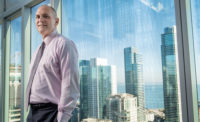The U.S. Dept. of Energy’s Jeffrey M. Baker, the visionary behind the nation’s newest symbol for sustainability, loves to recount the tale of the dreaded Kobayashi Maru test. For Baker, the fictional test from the “Star Trek” series is an allegory that became a guidepost during his 15-year crusade to develop a replicable model for the design and construction of affordable, ultra-green buildings.
As Baker tells it, Capt. James T. Kirk had failed the leadership training exercise twice as a cadet. Since Kirk knew the test, a simulated rescue mission, was rigged for failure, he secretly reprogrammed the simulator to give him at least a fair shot at victory. When Kirk took the test, he managed to rescue the disabled Kobayashi Maru, a distressed freighter stuck in the enemy’s neutral zone, and destroy all the enemy warships. While he had bent the rules, he became the first cadet to pass the test, thanks to his determination and outside-the-box thinking.
Like his fictional hero, Baker never gave up on his green-building odyssey, despite two devastating defeats along the way. And when faced with no-win scenarios, he changed the rules of the game. “Kirk knew what he had to do, and he figured out a way to work through it,” says Baker, director of laboratory operations in the Golden, Colo., field office of the Office of Energy Efficiency and Renewable Energy (EERE). “It’s a great philosophy,” adds Baker, who oversees the energy department’s National Renewable Energy Laboratory (NREL), also in Golden.
Also like Kirk, Baker ultimately turned his monumental mission into a mission accomplished. The lab’s $80-million Research Support Facility (RSF) open last June, in large part due to Baker’s persistence. The 220,000-sq-ft office building, packed with proven energy-efficient technologies, beats the national standard for energy consumption by 50%. Within months, the facility will rank as the world’s largest net-zero energy-use building, thanks to several photovoltaic arrays, which when complete, will produce as much energy as the building uses annually.
“This is going to change the way we think about energy performance in office buildings,” says Baker.
The facility also stands as a showcase for green-building technologies, some developed at the lab. The building also is a living laboratory for the study of sustainable operations, which is part of the lab’s mission to research, develop, demonstrate and deploy renewable energy and energy-efficient technologies.
“One of the most cost-effective ways for businesses to save money and improve their economic competitiveness is to reduce the energy needed to power their buildings and facilities,” says U.S. Energy Secretary Steven Chu. “[The RSF] is leading the way for the private sector by showing, firsthand, that it is possible to cost-effectively build facilities that reduce energy waste and save thousands of dollars on energy bills.”
Along the journey, the building team devised a new project delivery model for affordable, ultra-green office buildings. The performance-based, design-build model is considered revolutionary for the government and radical for the private sector. The lab will soon release a how-to manual to help others adapt the model.
| Do the right thing |
|---|
| Don’t let the perfect get in the way of the good |
| Never let them see you sweat |
| Always protect your people |
| Sometimes it’s better to ask forgiveness than permission |
| Never take no for an answer |
| Always keep your powder dry |
| Keep a sense of humor |
| It’s all good (even when it’s bad) |
For kicking open doors to extreme energy conservation and catalyzing the creation of a replicable delivery model for affordable, ultra-green buildings as well as triggering a transformation in the nation’s building energy future, Jeffrey M. Baker has been voted the 2011 Award of Excellence winner by the editors of Engineering News-Record.















Post a comment to this article
Report Abusive Comment